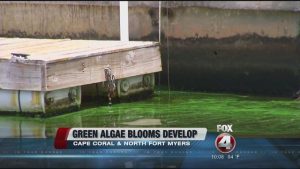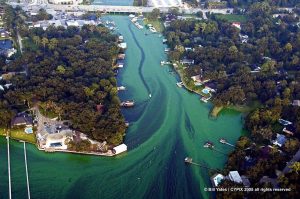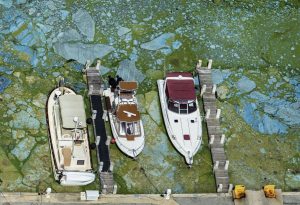‘Global Expo’ more about doing the right thing than algae blooms
 Filmmaker Camilo Vega-Martinez brought a short 2-minute film to this year’s Fort Myers Film Festival. The Global Expo follows new anchor Nate Floyd (played by Joshua Menghini), who has a career-changing decision to make live on air when he comes across evidence that he can no longer hide from the community. That evidence relates to Southwest Florida’s chronic blue-green algae problem.
Filmmaker Camilo Vega-Martinez brought a short 2-minute film to this year’s Fort Myers Film Festival. The Global Expo follows new anchor Nate Floyd (played by Joshua Menghini), who has a career-changing decision to make live on air when he comes across evidence that he can no longer hide from the community. That evidence relates to Southwest Florida’s chronic blue-green algae problem.
In the film, Floyd goes live with a binder containing evidence that people knew what is causing the algae blooms and acted with complete disregard for human and animal life. “This may be the  last night you see me on this channel,” Floyd says breathlessly, his mouth dry with fear and anxiety. “The fight’s begun and I need every one of you to help,” he implores as he walks off air.
last night you see me on this channel,” Floyd says breathlessly, his mouth dry with fear and anxiety. “The fight’s begun and I need every one of you to help,” he implores as he walks off air.
Fort Myers water woes are indeed manmade and people have understood the nature and scope of both the problem and the solution for a number of years. In fact, the Fort Myers Film Festival has been drawing attention to the  problem for some time. For example, FMFF opened the 7th Annual Fort Myers Film Festival on March 8, 2017 with Black Tide, a documentary that detailed the causes and possible solutions to our chronic water quality crisis.
problem for some time. For example, FMFF opened the 7th Annual Fort Myers Film Festival on March 8, 2017 with Black Tide, a documentary that detailed the causes and possible solutions to our chronic water quality crisis.
Surprisingly,  our water woes date back in time 171 years, when the very first Florida Legislature dreamed of draining the Everglades in order to create land for sugar cane and rice plantations. But it was a hurricane that struck the state in September of 1928 that created the predicate for our present dilemma. High winds and heavy rains
our water woes date back in time 171 years, when the very first Florida Legislature dreamed of draining the Everglades in order to create land for sugar cane and rice plantations. But it was a hurricane that struck the state in September of 1928 that created the predicate for our present dilemma. High winds and heavy rains  caused Lake Okeechobee to breach the modest levees that had been built to protect Belle Glades and Clewiston. Between 2,500 and 3,000 people died in the storm-driven flood. The Florida Legislature responded to the tragedy by creating the Okeechobee Flood Control District, and after a personal inspection, President Herbert Hoover directed the Army Corps of Engineers to formulated a plan to prevent a recurrence
caused Lake Okeechobee to breach the modest levees that had been built to protect Belle Glades and Clewiston. Between 2,500 and 3,000 people died in the storm-driven flood. The Florida Legislature responded to the tragedy by creating the Okeechobee Flood Control District, and after a personal inspection, President Herbert Hoover directed the Army Corps of Engineers to formulated a plan to prevent a recurrence  of the tragedy. The result was the Central and South Florida (C&SF) Project, which provided for the construction of floodway channels, control gates, and major levees along Lake Okeechobee’s shores.
of the tragedy. The result was the Central and South Florida (C&SF) Project, which provided for the construction of floodway channels, control gates, and major levees along Lake Okeechobee’s shores.
Construction of these flood control facilities presented Fort Myers’ legendary hardware magnate W.P. Franklin  with an opportunity to do something else. Since the days of Ponce de Leon, explorers, politicians and businessmen had dreamed of a cross-state waterway and now Franklin lobbied the Florida Legislature to expand the Central and South Florida Project to include the needed structures. Within no time, crews were digging a new and improved canal from Lake
with an opportunity to do something else. Since the days of Ponce de Leon, explorers, politicians and businessmen had dreamed of a cross-state waterway and now Franklin lobbied the Florida Legislature to expand the Central and South Florida Project to include the needed structures. Within no time, crews were digging a new and improved canal from Lake  Okeechobee to the headwaters of the Caloosahatchee and another east to Stuart. At the same time, the channel in the Caloosahatchee was deepened to seven feet from Fort Myers all the way upriver to Fort Thompson. The waterway’s opening was celebrated for two whole days, with Franklin leading a delegation from Fort Myers in a 40-boat watercade from Stuart to Fort Myers. But it was this
Okeechobee to the headwaters of the Caloosahatchee and another east to Stuart. At the same time, the channel in the Caloosahatchee was deepened to seven feet from Fort Myers all the way upriver to Fort Thompson. The waterway’s opening was celebrated for two whole days, with Franklin leading a delegation from Fort Myers in a 40-boat watercade from Stuart to Fort Myers. But it was this  cross-state waterway coupled with the dikes along the lake’s southern perimeter that created the predicate for the ecological damage and destruction that the Everglades, the Caloosahatchee, the St. Lucie and their estuaries are experiencing today.
cross-state waterway coupled with the dikes along the lake’s southern perimeter that created the predicate for the ecological damage and destruction that the Everglades, the Caloosahatchee, the St. Lucie and their estuaries are experiencing today.
The Herbert Hoover  Dike averages 30 feet in height, but there is a limit on the amount of hydrostatic pressure the earthen structures can withstand. Hydrostatic pressure increases linearly as the depth of the lake increases. The danger point is reached once the depth of Lake Okeechobee reaches between 18 and 20 feet. But if the water in Lake O rises
Dike averages 30 feet in height, but there is a limit on the amount of hydrostatic pressure the earthen structures can withstand. Hydrostatic pressure increases linearly as the depth of the lake increases. The danger point is reached once the depth of Lake Okeechobee reaches between 18 and 20 feet. But if the water in Lake O rises  above 15.5 feet, the vegetation at the bottom of the lake dies resulting in poor water quality, algae blooms, fish kills and other ecological losses. In addition, there is a practical limit to how quickly the lake’s water level can be reduced in the event of heavy rainfall or a tropical system. Therefore, the Army Corps of Engineers releases water from the lake whenever the water level rises above 14 feet, and that will remain true even after current
above 15.5 feet, the vegetation at the bottom of the lake dies resulting in poor water quality, algae blooms, fish kills and other ecological losses. In addition, there is a practical limit to how quickly the lake’s water level can be reduced in the event of heavy rainfall or a tropical system. Therefore, the Army Corps of Engineers releases water from the lake whenever the water level rises above 14 feet, and that will remain true even after current  initiative to repair and reinforce the dikes is completed.
initiative to repair and reinforce the dikes is completed.
Since there are no outlets to the south, the excess water can only go in one or two directions – either west into the Caloosahatchee River or east into the St. Lucie. The problem is that these releases contain a surfeit of fertilizers, pesticides, herbicides and animal effluent  from farms and cattle ranches upstream in the Kissimmee River Basin. While this situation is bad enough, the problem is compounded during times of high rainfall, heat and humidity, when blue green algae blooms smother the edges of Lake Okeechobee and pour through the W.P. Franklin Dam and Lock.
from farms and cattle ranches upstream in the Kissimmee River Basin. While this situation is bad enough, the problem is compounded during times of high rainfall, heat and humidity, when blue green algae blooms smother the edges of Lake Okeechobee and pour through the W.P. Franklin Dam and Lock.  The nutrient-enriched water cascading into the river further contribute to and exacerbate naturally-occurring blue-green algae blooms in the river and red tides in the Gulf of Mexico, and the suspended solids in the releases prevent photosynthesis, which kills sea grasses and other vegetation needed for spawning.
The nutrient-enriched water cascading into the river further contribute to and exacerbate naturally-occurring blue-green algae blooms in the river and red tides in the Gulf of Mexico, and the suspended solids in the releases prevent photosynthesis, which kills sea grasses and other vegetation needed for spawning.
The algae  blooms and red tides are more than just visually unattractive. They produce toxins that sicken and kill marine and wildlife and cause a host of human health risks. The latest research links them to respiratory and serious nervous system disorders. The incidence of childhood leukemia is more than five times the rate in other parts of the country.
blooms and red tides are more than just visually unattractive. They produce toxins that sicken and kill marine and wildlife and cause a host of human health risks. The latest research links them to respiratory and serious nervous system disorders. The incidence of childhood leukemia is more than five times the rate in other parts of the country.
 But from the Army Corps’ perspective, it’s merely a matter of hydrostatic pressure. Once the depth of the water in the lake exceeds 14.5 feet, the Corps discharges water into the Caloosahatchee and St. Lucie Rivers regardless of the consequences. Protecting the Herbert Hoover Dike and the concomitant commercial interests of Big Sugar is their paramount concern.
But from the Army Corps’ perspective, it’s merely a matter of hydrostatic pressure. Once the depth of the water in the lake exceeds 14.5 feet, the Corps discharges water into the Caloosahatchee and St. Lucie Rivers regardless of the consequences. Protecting the Herbert Hoover Dike and the concomitant commercial interests of Big Sugar is their paramount concern.
By 2006, the situation had become so dire that American Rivers named the Caloosahatchee the 7th most endangered river in the nation. “The scale of the damage to water quality, aquatic habitat, fish and wildlife … [is] a national level ecological tragedy,” said American Rivers,  noting that intense algae blooms have severely depleted oxygen levels in the Caloosahatchee, resulting in the decimation of the river’s commercial seafood and sports fishing species. Instrumental in American River’s condemnation of the river’s health was the fact that between 2000 and 2006, there were 570 days when the blue-green algae blooms were so bad that public health officials were compelled to issue orders prohibiting swimming in the river. That situation persists today.
noting that intense algae blooms have severely depleted oxygen levels in the Caloosahatchee, resulting in the decimation of the river’s commercial seafood and sports fishing species. Instrumental in American River’s condemnation of the river’s health was the fact that between 2000 and 2006, there were 570 days when the blue-green algae blooms were so bad that public health officials were compelled to issue orders prohibiting swimming in the river. That situation persists today.
And the damage extends far beyond the Caloosahatchee. Five National Wildlife Refuges depend on the Caloosahatchee River for water, including J.N. “Ding” Darling National Wildlife  Refuge, Caloosahatchee National Wildlife Refuge, Island Bay National Wildlife Refuge, Matlacha Pass National Wildlife Refuge, and Pine Island National Wildlife Refuge. Many are showing signs of impaired ecosystems as a result of the polluted waters of the Caloosahatchee.
Refuge, Caloosahatchee National Wildlife Refuge, Island Bay National Wildlife Refuge, Matlacha Pass National Wildlife Refuge, and Pine Island National Wildlife Refuge. Many are showing signs of impaired ecosystems as a result of the polluted waters of the Caloosahatchee.
Vega-Martinez experienced the aftermath of one of our algae blooms first hand. It happened when he took his canine to a local dog beach. “When we got there, it smelled really bad and there were dead fish everywhere,” Camilo explains.
Also an artist, Camilo was inspired to do a painting, which he donated to Captains for Clean Water and Caloosa Water Keepers.
 “All the money went to improve water quality in Southwest Florida,” Camilo shares. “I also did the walk from downtown Fort Myers to the water district. But film is a very powerful vehicle that enables us to comment on the problems society has, and this is one that affects our area and needs to be fixed.”
“All the money went to improve water quality in Southwest Florida,” Camilo shares. “I also did the walk from downtown Fort Myers to the water district. But film is a very powerful vehicle that enables us to comment on the problems society has, and this is one that affects our area and needs to be fixed.”
And so he was inspired to produce The Global Expo.
Toward that end, Camilo expects to post distribute the film through social media outlets in hopes that it goes viral or is at least viewed by enough people to sensitize them to our water issues.
 He also plans to continue working with Captains for Clean Water, Caloosa Water Keepers and other nonprofit organizations dedicated to improving our water quality.
He also plans to continue working with Captains for Clean Water, Caloosa Water Keepers and other nonprofit organizations dedicated to improving our water quality.
But while the film specially mentions algae blooms, The Global Expo’s broader theme is about doing the right thing and taking appropriate action no matter the personal cost. It’s a message for all times and all places, especially during a year denoted by the politicization of a worldwide pandemic, racial injustice and denial of the role which greenhouse gases are playing in causing the planet to warm and sea levels to rise.
October 26, 2020.














 Tom Hall is both an amateur artist and aspiring novelist who writes art quest thrillers. He is in the final stages of completing his debut novel titled "Art Detective," a story that fictionalizes the discovery of the fabled billion-dollar Impressionist collection of Parisian art dealer Josse Bernheim-Jeune, thought by many to have perished during World War II when the collection's hiding place, Castle de Rastignac in southern France, was destroyed by the Wehrmacht in reprisal for attacks made by members of the Resistance operating in the area. A former tax attorney, Tom holds a bachelor's degree as well as both a juris doctorate and masters of laws in taxation from the University of Florida. Tom lives in Estero, Florida with his fiancee, Connie, and their four cats.
Tom Hall is both an amateur artist and aspiring novelist who writes art quest thrillers. He is in the final stages of completing his debut novel titled "Art Detective," a story that fictionalizes the discovery of the fabled billion-dollar Impressionist collection of Parisian art dealer Josse Bernheim-Jeune, thought by many to have perished during World War II when the collection's hiding place, Castle de Rastignac in southern France, was destroyed by the Wehrmacht in reprisal for attacks made by members of the Resistance operating in the area. A former tax attorney, Tom holds a bachelor's degree as well as both a juris doctorate and masters of laws in taxation from the University of Florida. Tom lives in Estero, Florida with his fiancee, Connie, and their four cats.